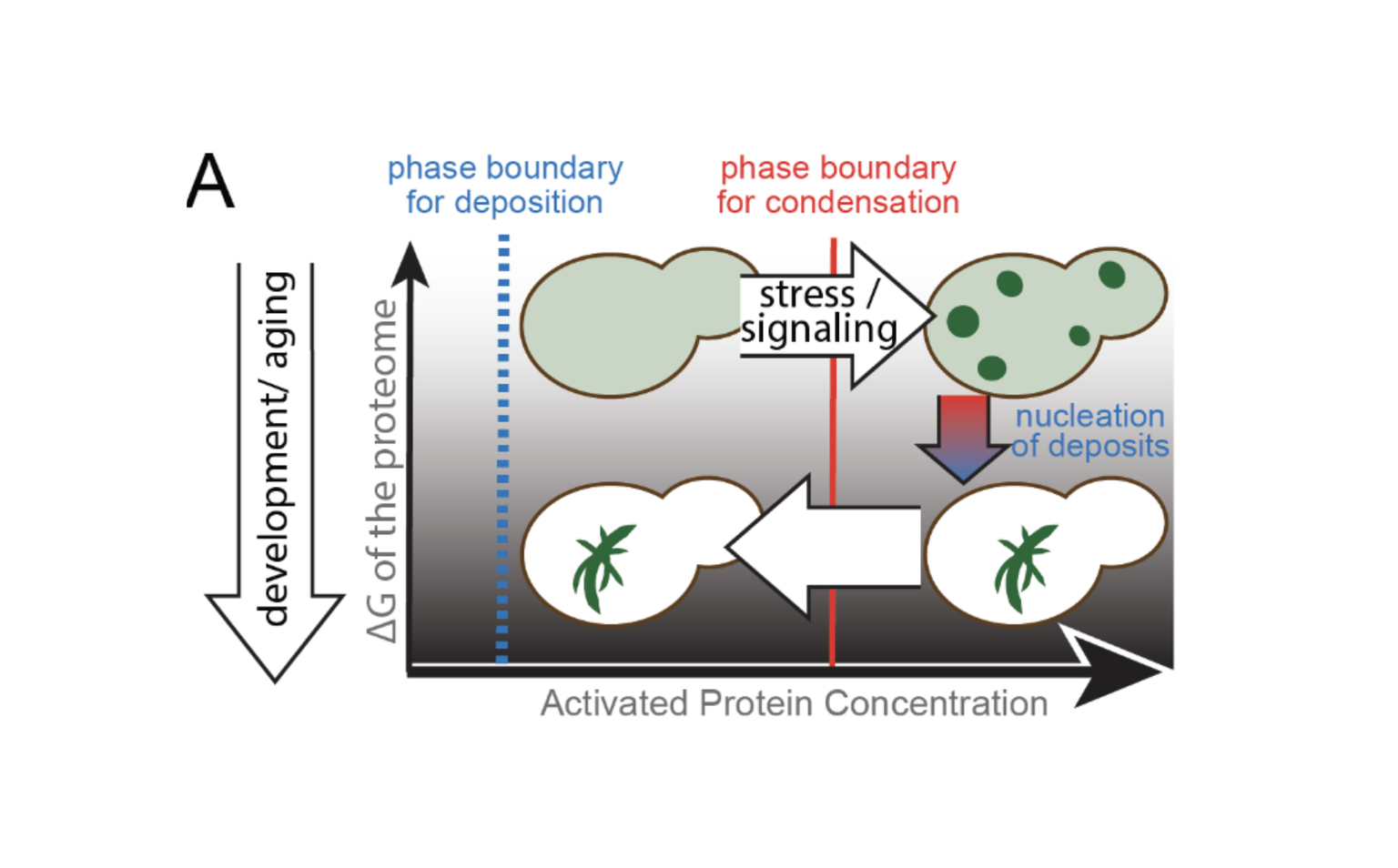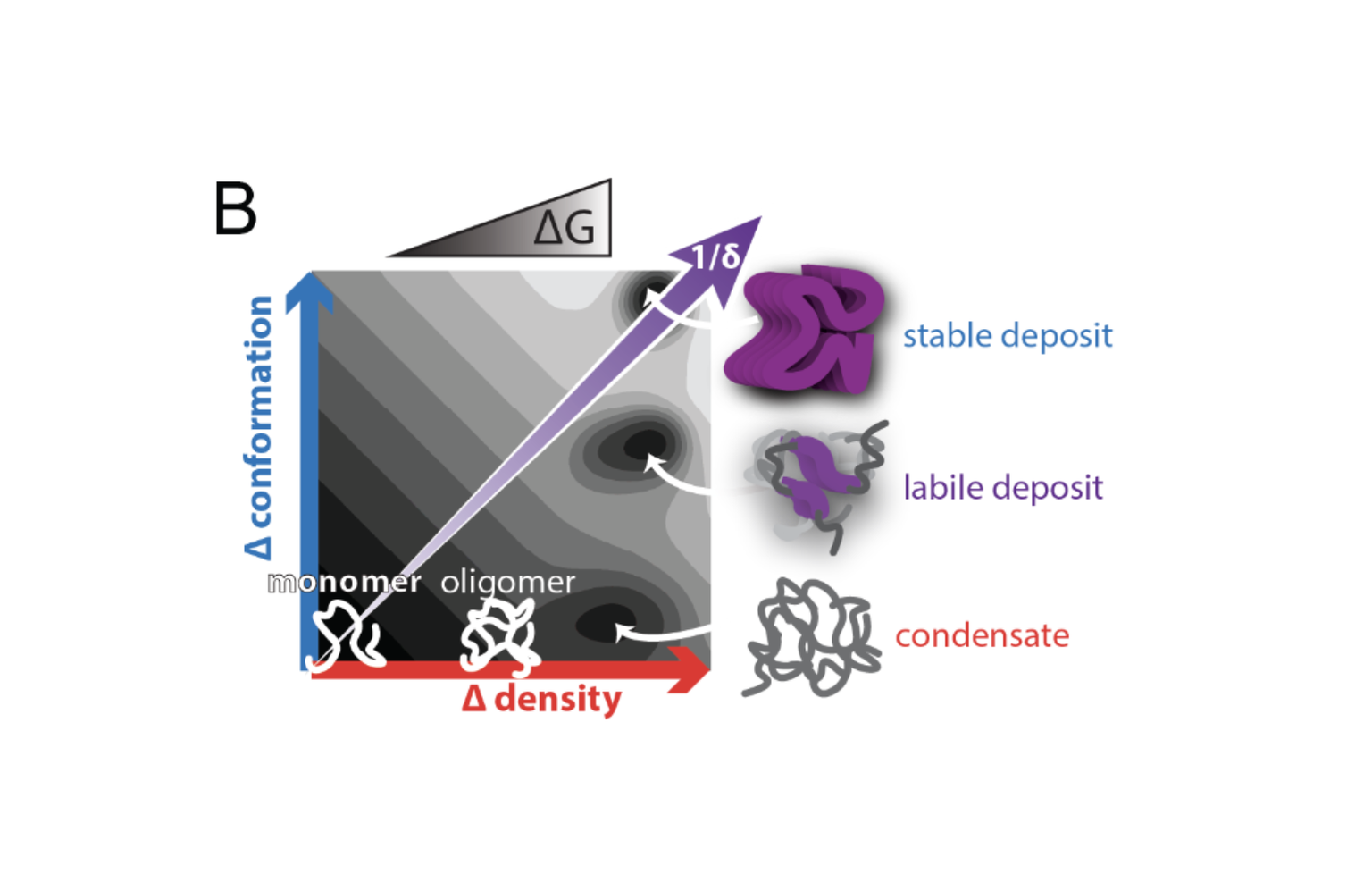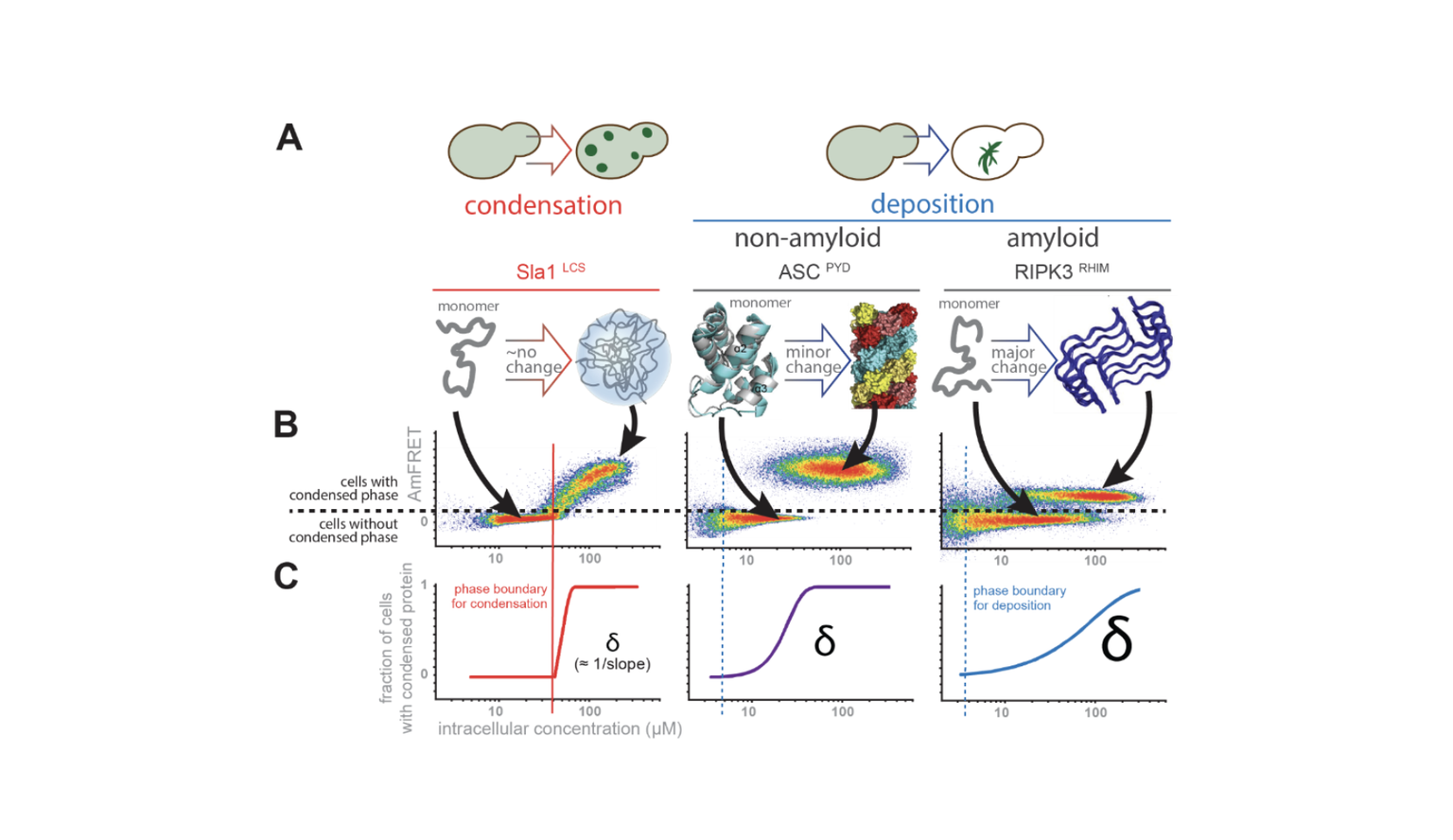Research
Research
Research Overview

An overarching goal of modern biology is to understand how biomolecules compartmentalize cellular processes at mesoscopic spatiotemporal scales -- that is, greater than the sizes and fluctuations of individual proteins, but smaller than the sizes and lifespans of cells. These emergent properties of biomolecules somehow orchestrate gene regulation and signaling.
The relatively recent appreciation that proteins can order themselves via liquid-liquid phase separation in vivo marked a turning point in our understanding of how cells work. An intrinsic feature of phase separation is nucleation, the energetically unfavorable event that dictates the probability of the new phase occurring de novo at any point in space and time. Whereas the implications of phase separation in organizing protein activities in intracellular space are now being feverishly uncovered in research labs around the world, the fact that the nucleation barriers inherent to phase separation can also control protein activity temporally over cellular and organismal time scales is only beginning to assimilate into biological discourse. The Halfmann Lab is making those discoveries.

We seek to uncover fundamental relationships between nucleation barriers and directional cellular changes that abound in biology. These collectively underlie physiological and pathological phenomena ranging from cell differentiation and development on the one hand, to neurodegeneration and aging on the other. The central tenet of our research holds that nucleation barriers render living proteomes perpetually high energy, or supersaturated, with respect to ordered protein assemblies such as amyloids, and this provides a driving force for inevitable and irreversible declines in cellular phenotypic potential.
Our Research
Quantifying Protein Supersaturation
Development of technologies to quantify protein supersaturation in cells
The molecular and cellular factors that determine nucleation barriers are unclear, and their study has been virtually impossible with established technologies. In 2018 we published the development of a direct, positive reporter of protein self-assembly as a function of intracellular concentration. Distributed Amphifluoric FRET, or DAmFRET, is a straight-forward flow cytometry-based approach that reveals the existence and magnitude of sequence-encoded nucleation barriers in living cells. Through a series of experiments manipulating the conformational preferences and local densities of structurally characterized proteins in vivo, we showed that nucleation barriers of biologically relevant magnitude involve a major conformational change in the protein, and that the ability of proteins to act as epigenetic elements, or “prions”, emerges from this relationship.
We are actively developing a successor to DAmFRET with improved spatial and temporal resolution, which will allow us to dissect the structural basis for phase transitions ranging from liquid-liquid phase separation to amyloid and non-amyloid polymerization. We complement these efforts with established microscopy (FCS, FRAP, STED), biochemistry(SEC, SDD-AGE, structure-specific dyes), and proteomics approaches.

How to interpret a DAmFRET plot.
A) Cartoon illustration of disordered and ordered protein phase separation (condensation and deposition, respectively) within cells. The latter typically occurs in the form of one-dimensional pseudocrystals, or polymers, of either folded protein subunits (“non-amyloid”) or unfolded polypeptides (“amyloid”). A structurally characterized protein representative of each type of phase separation is shown, in both its monomer and assembled forms. The degree to which nucleation, as deduced from these structures, is limited by intramolecular conformational changes increases from left to right.
B) Representative DAmFRET plots of these proteins. which show how the indicated protein interacts with itself (AmFRET) as a function of its cytosolic concentration at a single time point. This relationship informs on the strength and stoichiometry of self-assemblies, as well as the existence of intrinsic kinetic barriers to their formation. Any stochasticity in the onset of self-assembly introduces a bifurcation in the relationship, resulting in two or more populations of cells characterized by different FRET levels even at the same level of expression. The dashed line indicates the mean FRET-level for monomeric mEos3.1.
C) Schematic depiction of the data in E) showing the fraction of cells containing self-assemblies as a function of the protein’s concentration. These are fit to a phenomenological function to derive the parameter 𝛅 that describes the persistence of the bifurcation with increasing concentration; 𝛅 increases with the height of the intramolecular energy barrier that limits nucleation. The value of 𝛅 is lowest for disordered condensation and highest for amyloid deposition. Dashed gray lines denote saturating concentrations deduced from the data.
Sequence determinants of supersaturation
We are keen to know how metastability is encoded by sequence. We are presently addressing this from complementary directions.
A bottom-up approach
We took the simplest sequence capable of nucleation-limited polymerization -- pure poly-glutamine -- and increased complexity by doping in specific residues to identify those that either increased or decreased amyloid nucleation. This approach revealed that simple sequences can form two fundamentally different forms of amyloid, with distinct physiological consequences that have been acted on by evolution, and a simple sequence pattern governing the preference of a given protein for one form or the other (Kandola et al. in preparation).
A top-down approach
We rationally mutated an archetypal prion-like protein, human TDP-43, to iteratively identify and dissect sequence features controlling self-assembly. Using DAmFRET and orthogonal techniques we found that dynamic secondary- and tertiary structural features drive the protein into five distinct and kinetically coupled phases in yeast cytosol -- monomers, micellar oligomers, condensates (when stressed),atypical amyloids, and typical amyloids (Wu et al. in preparation). What has emerged from this work is – to our knowledge – the first empirical energy landscape of protein phase behavior in living cells. This landscape illustrates a competition between micellar oligomers and condensates that is governed by a conformational switch within a short hydrophobic segment. Each of these metastable states represent a distinct pathway for nucleation leading to distinct amyloid forms.
How do cells use supersaturation?
Supersaturation in innate immune signaling
A growing number of proteins have been observed to transduce intracellular signals via self-templating polymerization that is reminiscent of prions. The nucleation barrier to polymerization is so high for these proteins that their soluble inactive states persist despite physiological concentrations that are highly supersaturated with respect to the assembled active state. In other words, the assembled active state is in fact thermodynamically favored over the dispersed inactive state, even in the absence of stimulation. By extension, activation is inevitable and only temporarily prevented by structurally-encoded nucleation barriers to inflammasome assembly.
This fact -- that life uses nucleation barriers to govern cell fate decisions -- has profound implications for our understanding of aging and development. In particular, it means that the phenotypic potential of a cell (its ability to respond effectively to different stimuli) is ultimately controlled kinetically, and must therefore decrease with time. Indeed, the loss of phenotypic potential-- in the form of cell senescence -- drives chronic inflammation that has recently emerged as a central hallmark of aging.
We have used DAmFRET to discover multiple additional human proteins with an intrinsic capacity to transduce cellular signals through nucleation-limited self-assembly. We found that this capacity is conserved in homologous proteins from basal metazoans, suggesting an ancient form of signaling that limits metazoan cell plasticity with the passage of time. We are now seeking to answer the most pressing question raised by this research: Why are innate immune signaling pathways structured in such a way that our cells are literally waiting to die?
Driving Force in Aging
Dependence of nucleation on translation flux
Living proteomes are necessarily far from equilibrium. Otherwise cells could not use the energy released by phase separation to organize protein activities in space and time. It is paradoxical, then, that reducing protein influx into the proteome -- which should promote equilibration -- instead prolongs the lives of organisms from yeast to human. We therefore reason that kinetic barriers must exist to delay equilibration, and that these decrease with protein influx. We are investigating the extent to which the probabilistic nucleation of protein self-assemblies underlies those barriers.
Our progress thus far suggests that living proteomes are supersaturated with respect to highly ordered, collectively lethal self-assemblies (Venkatesan et al. in preparation). This line of work will advance our understanding of cellular adaptation, memory, and aging, all of which exhibit poorly understood dependencies on protein influx and phase separation.
The Halfmann Lab's impact on brain and memory research.